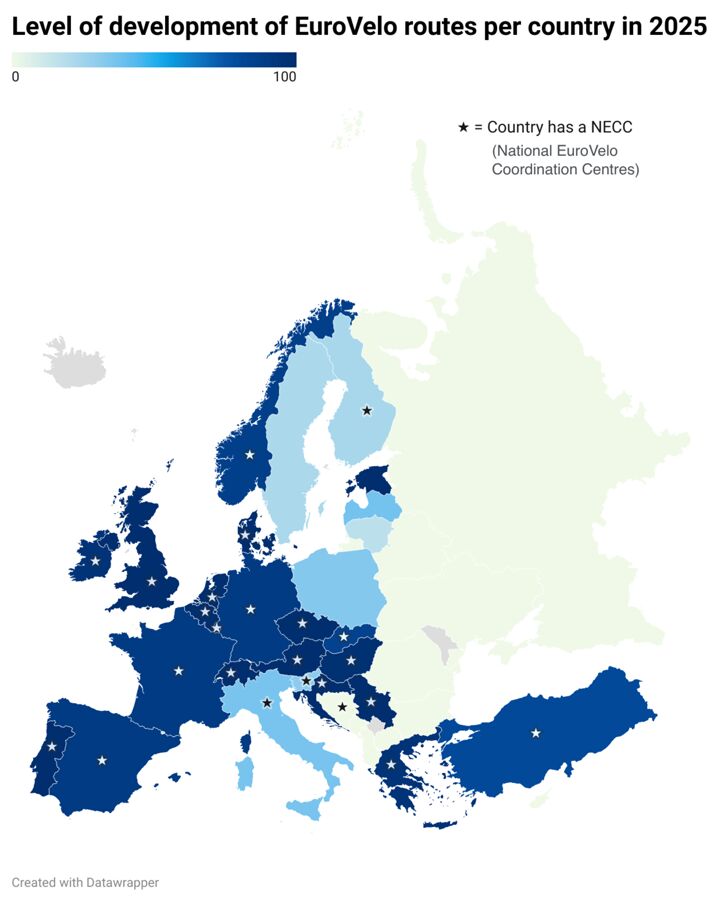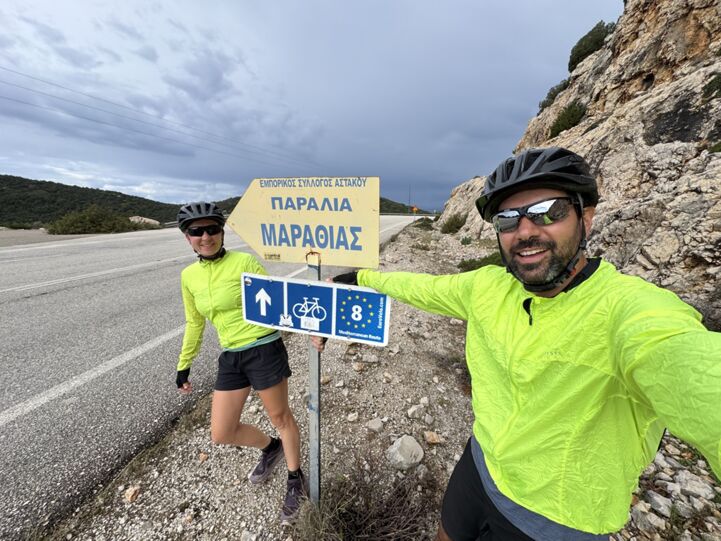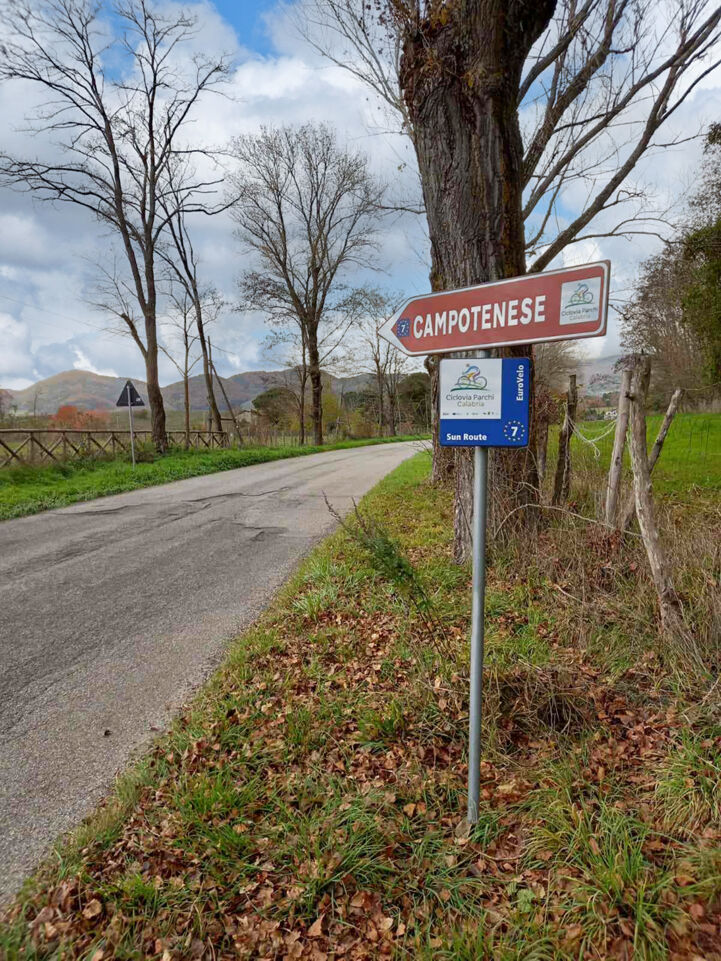Advancing EuroVelo: Insights and Practical Approaches from the 2025 Route Development Status Report
The latest edition of the EuroVelo Route Development Status Report has just been released! As always, it’s packed with essential figures: the updated total length of the network (now 91,812 km), how much of it is ready to cycle (63,157 km), and how much is already signed with EuroVelo signage (38,457 km). You’ll also find updated classifications of EuroVelo routes and countries based on their development levels – check out the report to see where your country stands!
One notable shift in this year’s ranking is the rise of EuroVelo 1 – Atlantic Coast Route in France, which moved up to third and second place in their respective classifications. This progress is largely connected to the EuroVelo Certification awarded to EuroVelo 1 in France (La Vélodyssée) in September 2024.
Another highlight? A new country has joined the EuroVelo network! Liechtenstein officially became part of it in June 2025, thanks to the 62-km extension of EuroVelo 15 – Rhine Cycle Route to the right bank of the Rhine River along the Swiss border. This also added a new high-quality EuroVelo section in Austria of 36 km.

But the real focus of this year’s report is the future. We’re laying out clear, practical steps to fully complete the EuroVelo network by 2030 – now just around the corner! Our article on last year’s report ended with a call for action for national stakeholders involved in EuroVelo route developments to follow the recommendations and guidelines in the EuroVelo Development Guide. So this year, we looked into what actions were taken.
Good news: some countries have heard the call and we’ve got inspiring stories to share. Indeed, we have dedicated a new chapter to three countries – Greece, Italy and Poland – showcasing different approaches they took to accelerate EuroVelo developments with pragmatic actions. These approaches can be summed up as: make it continuous, bring it where it’s good and coordinate. Dive into the report for the full breakdown of these good practices!
Make it continuous
As of 2025, 69% of the 91,800+ km EuroVelo network is developed – including 3% certified sections, 39% with EuroVelo signage, and 27% developed but unsigned. That’s a 2% increase over 2024 – and it’s mostly thanks to one country: Greece.

Greece added 1,300 km of EuroVelo 8 – Mediterranean Route and EuroVelo 11 – East Europe Route by mapping out the most suitable continuous itineraries using its secondary road network and existing cycling infrastructure where available. These routes are considered safe in terms of traffic volume and speed, and they meet all criteria for accommodation and related services. As a result, EuroVelo routes in Greece are now 96% developed!
Let’s take a moment to imagine: what if larger countries with low EuroVelo development and extensive low-traffic secondary roads did the same kind of work? If just a few followed this path, the network’s development rate could increase dramatically.
This approach is especially valuable when political momentum is high. With modest budget impact, field surveys can provide crucial insights into cycling conditions, helping to identify the most promising continuity options while outlining future improvements. The European Certification Standard methodology, developed by ECF, is perfect for this type of assessment – assessing the quality of cycle routes based on a set of criteria tailored to cycle tourists. It can also be used to choose best continuity options at an early stage in route development.
Bring it where it's good

In early 2025, the first EuroVelo signs were installed along a 640-km section of EuroVelo 7 – Sun Route in Italy. This success followed the 2024 re-routing of a difficult coastal section (which was challenging to develop) to the inland Ciclovia dei Parchi in Calabria – a cycle route that was already in place.
In this case, development leapt forward simply by re-aligning the route to an existing corridor. Even though this route displayed a more challenging topography, the Region of Calabria was showing strong commitment to develop it further. Re-routing is a quick and effective way to boost development rates, and can be readily made as long as the new route lies within 50 km of the original. Exceptions can be made if the change integrates EuroVelo with official national or regional cycle networks and opens up stronger development prospects.
This approach is particularly useful when the original route is not progressing or lacks local support. As long as the theme and general geographical area of the route remain unchanged, re-routing is a fast way to align with local priorities and improve the development level and relevance of a EuroVelo route. For more important re-routings or for proposing a new EuroVelo route or section, see the New Routes and Major Extensions Manual.
Coordinate
Coordination isn’t just about working better together – in some cases, it can immediately raise a country’s development rate by simply uncovering previously unknown information. That’s exactly what happened in Poland. As part of the process to create a National EuroVelo Coordination Centre (NECC) (a process not yet finalised in August 2025), the Polish Tourism Organisation (PTO) collected and consolidated information that had been scattered across multiple stakeholders – resulting in a 6% development increase in 2025.
Starting with coordination makes sense in countries where no NECC or formal EuroVelo coordination mechanism exists yet. Centralising data and establishing a coordination body are the first steps to long-term improvements. EuroVelo routes tend to be more developed and better maintained in countries where an NECC is active. If you would like to establish an NECC in your country, the process to become one is outlined on this page.

Let us know your thoughts on this year’s developments, and don’t miss the full report for detailed insights by route and by country, inspiring practices ready to be replicated, and even more colourful maps! We’ll be back next year to kick off a new chapter, as an ongoing update to EuroVelo development categories is set to bring significant changes to our route database – all for the better. The goal? A more accurate reflection of real on-the-ground conditions, giving cyclists more realistic expectations when planning their journeys.
Author: Florence Grégoire
Cover picture: EuroVelo 10 - Baltic Sea Cycle Route in Kolobrzeg, Poland. Copyright: Archives of Marshal's Office of the West Pomeranian Voivodship